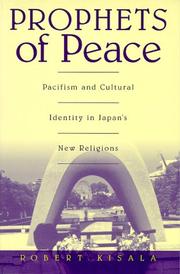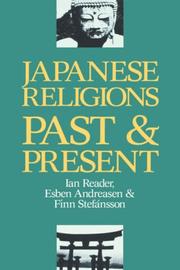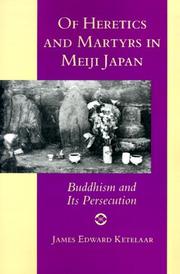| Listing 11 - 15 of 15 | << page >> |
Sort by
|
Book
ISBN: 2716903220 Year: 2000 Publisher: S.L. Publications Orientalistes de France
Abstract | Keywords | Export | Availability | Bookmark
 Loading...
Loading...Choose an application
- Reference Manager
- EndNote
- RefWorks (Direct export to RefWorks)
Japan --- Religion. --- religions --- shinto --- bouddhisme continental --- bouddhisme japonais --- syncrétisme --- politique et religion --- shintoïsme --- Kojiki (古事記) --- Kami (神) --- shingon bouddhisme --- tendai bouddhisme --- Nichiren Bouddhisme --- zen bouddhisme --- Yamabushi (山伏) --- hijiri (聖) --- miko (巫女) --- rêves --- lune --- danses sacrées --- magie --- sorciers --- Motoori Norinaga (本居宣長) --- Hirata Atsutane (平田篤胤) --- Japon

ISBN: 0824822676 Year: 1999 Publisher: Honolulu University of Hawaii press
Abstract | Keywords | Export | Availability | Bookmark
 Loading...
Loading...Choose an application
- Reference Manager
- EndNote
- RefWorks (Direct export to RefWorks)
Pacifism --- Religious aspects --- Japan --- Religion --- pacifism --- cultural identity --- Japanese new religions --- Japanese religion --- peace studies --- sociology --- Soka Gakkai (創価学会) --- Motoori Norinaga (本居宣長) --- Kokugaku (国学) --- Nipponzan Myohoji (日本山妙法寺) --- Byakko Shinko Kai (White Light Association) --- Goi Masahisa (五井昌久) --- Byakko Shinkokai (白光真宏会) --- Rissho Kosei Kai (立正佼成会) --- Shoroku Shinto Yamatoyama (松緑神道大和山) --- Shuyodan Hoseikai (捧誠会) --- Idei Seitaro (出居清太郎) --- surveys --- questionnaires

ISBN: 0824815467 Year: 1995 Publisher: Honolulu University of Hawaii press
Abstract | Keywords | Export | Availability | Bookmark
 Loading...
Loading...Choose an application
- Reference Manager
- EndNote
- RefWorks (Direct export to RefWorks)
Japan --- Religion. --- Japanese culture --- Japanese religion --- folk religion --- Shinto --- Buddhism --- new religions --- Christianity --- religion and politics --- shintoism --- Japanese new religious movements --- Kami (神) --- Tenrikyo (天理教) --- Soka Gakkai (創価学会) --- Rissho Kosei Kai (立正佼成会) --- Seicho no Ie (生長の家, House of Growth) --- Itto-en --- japanese language --- Kannon (観音) --- Kojiki (古事記) --- Ise (伊勢市) --- shinto shrines --- pilgrimage --- Ittoen (一燈園) --- Motoori Norinaga (本居宣長) --- Mahikari (真光)
Book

ISBN: 0870404318 Year: 1978 Publisher: Tokyo Japan culture institute
Abstract | Keywords | Export | Availability | Bookmark
 Loading...
Loading...Choose an application
- Reference Manager
- EndNote
- RefWorks (Direct export to RefWorks)
Japan --- Shōtoku Taishi --- Tenmu --- Kakinomoto no, Hitomaro --- Yamanoue no, Okura --- Ōtomo, Yakamochi --- Kūkai --- Saichō --- Fujiwara no, Michinaga --- Murasaki Shikibu --- Sei Shōnagon --- Taira no, Kiyomori --- Minamoto no, Yoritomo --- Minamoto no, Yoshitsune --- Hōjō, Masako --- Shinran --- Nichiren --- Kusunoki, Masashige --- Ashikaga, Takauji --- Ashikaga, Yoshimitsu --- Ashikaga, Yoshimasa --- Takeda, Shingen --- Oda, Nobunaga --- Toyotomi, Hideyoshi --- Tokugawa, Ieyasu --- Sen no, Rikyū --- Takayama, Justo --- Ihara, Saikaku --- Matsuo, Bashō --- Chikamatsu, Monzaemon --- Arai, Hakuseki --- Motoori, Norinaga --- Tanuma, Okitsugu --- Ryōkan --- Rai, San'yō --- Miura, Meisuke --- Sakamoto, Ryōma --- Ōkubo, Toshimichi --- Shibusawa, Eiichi --- Konoe, Fumimaro --- Tōjō, Hideki --- Kawabata, Yasunari

ISBN: 0691024812 Year: 1993 Publisher: Princeton Princeton university press
Abstract | Keywords | Export | Availability | Bookmark
 Loading...
Loading...Choose an application
- Reference Manager
- EndNote
- RefWorks (Direct export to RefWorks)
How did Buddhism, so prominent in Japanese life for over a thousand years, become the target of severe persecution in the social and political turmoil of the early Meiji era? How did it survive attacks against it and reconstitute itself as an increasingly articulate and coherent belief system and a bastion of the Japanese national heritage? Here James Ketelaar elucidates not only the development of Buddhism in the late nineteenth century but also the strategies of the Meiji state.
Buddhism --- Japan --- History --- 1868-1945 --- Buddhists --- Persecutions --- Social aspects --- J1800.70 --- J1857 --- J1864 --- J1861 --- J1701 --- J1700.70 --- Japan: Religion -- Buddhism -- history -- Kindai (1850s- ), bakumatsu, Meiji, Taishō --- Japan: Religion -- Buddhism -- apologetics, missionary works, proselytization --- Japan: Religion -- Buddhism -- relation with state and politics --- Japan: Religion -- Buddhism -- relation with Shintō (and Shinbutsu) --- Japan: Religion in general -- policy, legislation, guidelines, codes of behavior --- Japan: Religion in general -- history -- Kindai (1850s- ), bakumatsu, Meiji, Taishō --- Religiöse Verfolgung. --- Buddhismus. --- Buddhism. --- Persecutions. --- Social aspects. --- Japan. --- Aizawa Seishisai. --- Anesaki Masaharu. --- Bureau of Tombs. --- Christianity. --- Confucianism. --- Darwin, Charles. --- Eleven Themes. --- Emperor Jimmu. --- Emperor Komei. --- Eto Shimpei. --- Fujita Toko. --- FukubaBisei. --- Fukuda Gyokai. --- Fukuzawa Yukichi. --- Goi Ranju. --- Han Yu. --- Hirai Kinzo. --- Hirata Atsutane. --- Hirata School. --- Inoue Tetsujiro. --- IshikawaTairei. --- Iwakura Tomomi. --- Juge Shigekuni. --- Kamei Koremi. --- Kikuchi Taketoki. --- Kishimoto Nobuta. --- Kusunoki Masashige. --- Ministry of State (Dajokan). --- Mito. --- Mori Arinori. --- Motoori Norinaga. --- Murakami Senshō. --- Nakai Chikuzan. --- Okubo Toshimichi. --- Okuma Shigenobu. --- Ozu Tetsunen. --- Saigo Takamori. --- Senke Takatomi. --- Seventeen Themes. --- Shibata Reiichi. --- Tanaka Yoritsune. --- Teaching Academies. --- Toyotomi Hideyoshi. --- anti-Buddhist legislation. --- carnivalesque. --- cosmopolitanism. --- decadence. --- festival calendar. --- jinsei. --- national essence. --- temple registration. --- Lamaists --- Religious adherents --- Buddha and Buddhism --- Lamaism --- Ris-med (Lamaism) --- Religions --- Persecution --- al-Yābān --- Giappone --- Government of Japan --- Iapōnia --- I︠A︡ponii︠a︡ --- Japam --- Japani --- Japão --- Japon --- Japonia --- Japonsko --- Japonya --- Jih-pen --- Mư̄ang Yīpun --- Nihon --- Nihon-koku --- Nihonkoku --- Nippon --- Nippon-koku --- Nipponkoku --- Prathēt Yīpun --- Riben --- State of Japan --- Yābān --- Yapan --- Yīpun --- Zhāpān --- Япония --- اليابان --- يابان --- 日本 --- 日本国 --- Jepun --- Yapon --- Yapon Ulus --- I︠A︡pon --- Япон --- I︠A︡pon Uls --- Япон Улс --- Religion --- Buddhist --- Buddhistische Philosophie --- Religionsverfolgung --- Verfolgung --- Glaubensflüchtling --- Prayer-books and devotions --- Tibetan --- I͡Aponii͡ --- Empire du Japon --- Zen-Nihon --- Zenkoku --- Dainihon --- Dainippon --- Japão --- Japaner
| Listing 11 - 15 of 15 | << page >> |
Sort by
|

 Search
Search Feedback
Feedback About UniCat
About UniCat  Help
Help News
News